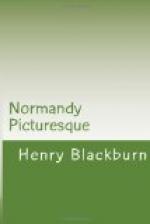All this, and much more the artist finds to his hand, and what does the architect discover? First of all, that if he had only come here before he might have saved himself an immensity of thought and trouble, for he would have found such suggestions for ornament in wood carving, for panels, doorways, and the like, of so good a pattern, and so old, that they are new to the world of to-day; he would have found houses built out over the rivers, looking like pieces of old furniture, ranged side by side—rich in colour and wonderfully preserved, with their wooden gables, carved in oak of the fifteenth century, supported by massive timbers, sound and strong, of even older date. He would see many of these houses with windows full of flowers, and creepers twining round the old eaves; and long drying-poles stretched out horizontally, with gay-coloured clothes upon them, flapping in the wind—all contrasting curiously with the dark buildings.
But he would also find some houses on the verge of ruin. If he explored far enough in the dark, narrow streets, where the rivers flow under the windows of empty dwellings; he might see them tottering, and threatening downfall upon each other—leaning over and casting shadows, black and mysterious upon the water—no line perpendicular, no line horizontal, the very beau-ideal of picturesque decay—buildings of which Longfellow might have sung as truly as of Nuremberg,—
“Memories haunt thy pointed gables,
Like the rooks which round them throng.”
In short, he would find Pont Audemer, and the neighbouring town of Lisieux, treasure houses of old mysterious ‘bits’ of colour and form, suggestive of simple domestic usage in one building, and princely grandeur in another—strength and simplicity, grace and beauty of design—all speaking to him of a past age with the eloquence of history.
Let us look well at these old buildings, many of them reared and dwelt in by men of humble birth and moderate means—(men who lived happily and died easily without amassing a fortune)—let us, if we can, without too much envy, think for a moment of the circumstances under which these houses were built. To us, to many of us, who pay dearly for the privilege of living between four square walls (so slight and thin sometimes, that our neighbours are separated from us by sight, but scarcely by sound)—walls that we hire for shelter, from necessity, and leave generally without reluctance; that we are prone to cover with paper, in the likeness of oak and marble, to hide their meanness—these curious, odd-shaped interiors, with massive walls, and solid oak timbers, are especially attractive. How few modern rooms, for instance, have such niches in them, such seats in windows and snug corners, that of all things make a house comfortable. Some of these rooms are twenty feet high, and are lighted from windows in surprising places, and of the oddest shapes. What more charming than this variety, to the eye jaded with monotony; what more suggestive, than the apparently accidental application of Gothic architecture to the wants and requirements of the age.[7]




